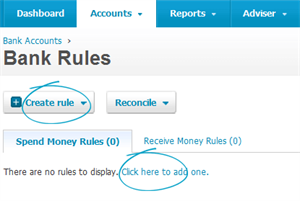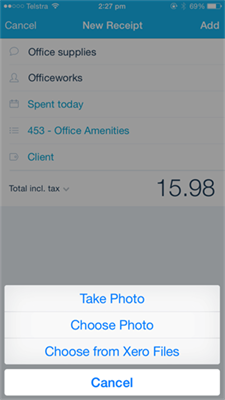23 July 2023 | Written by Richard A Crofts, Director
Helping local businesses to grow and pay less tax | Small enough to care
How we use Xero to manage our own business - useful tips
Here at Taxwise Accounting, we work with clients who use a variety of software platforms, but for our own business financials, we chose Xero. Rather than just listing generic tips sourced from the internet, I thought it would be more useful to share with you how we use Xero here and the tips and tools that we have come across since switching to the cloud many years ago. It is fair to say, some of the automation is nothing short of ground-breaking!
BANK RULES
We use GoCardless for collecting direct debit payments from clients on monthly payment plans, but we also have some smaller clients who we issue an invoice to periodically. For these, we raise an invoice in Xero and when the client opens up the PDF invoice, they are presented with the following options:
- View online
- Pay online
- Pay via PayPal
Clients can still make a manual or BACS transfer into our bank account or send a good old fashioned cheque, but by using the Payment Services intergration to offer more flexibility, our cash flow has vastly improved.
- View online
- Pay online
- Pay via PayPal
Clients can still make a manual or BACS transfer into our bank account or send a good old fashioned cheque, but by using the Payment Services intergration to offer more flexibility, our cash flow has vastly improved.
ONLINE PAYMENTS
As you will gather by the end of this article, I am very big on automation, so the auto bank feeds were the key driver in our decision to move our internal accounts into the cloud. Xero pulls in all of our bank transactions each day, but we still have to tell the software what to do with each transaction and this is where the bank rules function is useful to us.
For payments going out of the bank account that already have an associated purchase invoice, Xero will automatically match these payments to the relevant purchase invoice. For bank payments where we haven't already posted an invoice, we use bank rules set up to take care of these. For example, we have bank rules set up for bank charges, direct debit payments and net wages payments.
For payments going out of the bank account that already have an associated purchase invoice, Xero will automatically match these payments to the relevant purchase invoice. For bank payments where we haven't already posted an invoice, we use bank rules set up to take care of these. For example, we have bank rules set up for bank charges, direct debit payments and net wages payments.
MOBILE
I personally spend a lot of time out on the road visiting clients and often end up collecting numerous loose paper receipts, i.e. fuel receipts, meals, parking tickets etc. The way I deal with these is, as soon as I am given a receipt, I open up the Xero app on my smart phone, click on 'receipts' and the + button, then click the camera button and snap an image of the receipt. I then select an account to post the transaction to, i.e. stationery, travel etc., type a brief note of what it was for, the amount and select payment source then click the submit button. I then immediately throw the receipt away, feeling strangely satisfied!
Then (if I have spent using the business debit card) when Xero pulls the bank transaction in, it will automatically match the bank payment to the transaction. It doesn't get much easier than that!
Then (if I have spent using the business debit card) when Xero pulls the bank transaction in, it will automatically match the bank payment to the transaction. It doesn't get much easier than that!
RECEIPT SCANNING APPS
As with a lot of businesses, we receive lots of purchase invoices via email. Without automation, these email invoices would have to be downloaded (or worse - printed) and saved, then entered into the books manually. This brings me onto our biggest time saver of all... receipt / invoice recognition software.
We use Hubdoc but others are AutoEntry which is really impressive and of course Dext.
When we receive an invoice via email, we immediately forward the email to our Hubdoc mailbox. Hubdoc will then extract information from the invoice, such as date, supplier name, invoice number, description, vat rate and amounts. I then log into Hubdoc periodically and hit the 'review' button. This then presents me with the actual invoice on the left, and the information extracted on the right, which I can edit if necessary (hardly ever). Then, Upon clicking 'accept', the transaction and associated electronic invoice is posted into Xero for me, ready to be paid.
We use Hubdoc but others are AutoEntry which is really impressive and of course Dext.
When we receive an invoice via email, we immediately forward the email to our Hubdoc mailbox. Hubdoc will then extract information from the invoice, such as date, supplier name, invoice number, description, vat rate and amounts. I then log into Hubdoc periodically and hit the 'review' button. This then presents me with the actual invoice on the left, and the information extracted on the right, which I can edit if necessary (hardly ever). Then, Upon clicking 'accept', the transaction and associated electronic invoice is posted into Xero for me, ready to be paid.
XERO INVOICE CUSTOMISATION
The standard invoice templates provided by Xero are fine, but the design didn't really fit with our branding. There are two ways to customise your invoices in Xero. The first is via settings > general settings > invoice settings > then you can either edit an existing theme or add a new standard branding theme. This allows you to upload a logo, edit the terminology, adjust margins etc. This is the way most users customise their templates.
However, there is also the option to add a completely custom set of templates, by selecting new branding theme > custom .docx
This way, you are given a zip folder containing the Xero standard templates in Microsoft Word format. You can then modify the word templates however you like, and then upload the customised document back into Xero. It is not as difficult as it first looks, particularly if you know your way around MS Word.
However, there is also the option to add a completely custom set of templates, by selecting new branding theme > custom .docx
This way, you are given a zip folder containing the Xero standard templates in Microsoft Word format. You can then modify the word templates however you like, and then upload the customised document back into Xero. It is not as difficult as it first looks, particularly if you know your way around MS Word.
Our final tip is short and sweet but is useful for credit control purposes. By turning on invoice reminders, you can set Xero to automatically email customers who have invoices outstanding. So you could set it to email customers who haven't paid after 14 days, 28 days etc. and you can turn reminders off for certain customers.
AUTO INVOICE REMINDERS



1
2
3
4
5
6
Hopefully I've given some insight into how we use Xero internally - there are many more hints and tips I could give so if you would like me to do a follow up article or if you are interested in hearing about more hints and tips etc, the easiest way to indicate to me is by liking the page or dropping me a line via social media. If you have any specific questions, you can also drop me an email at richard@taxwise-accounting.co.uk
Thanks for reading.
Thanks for reading.